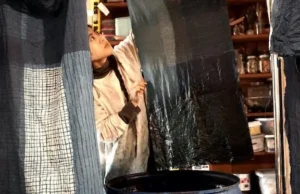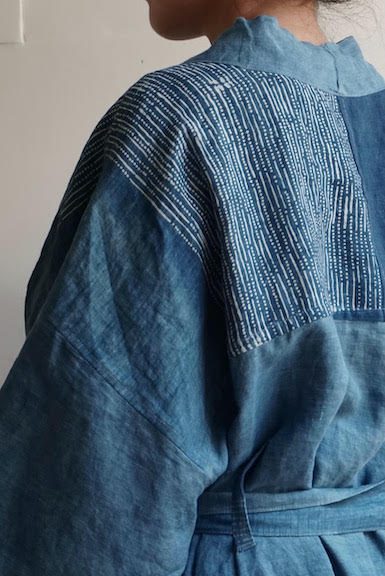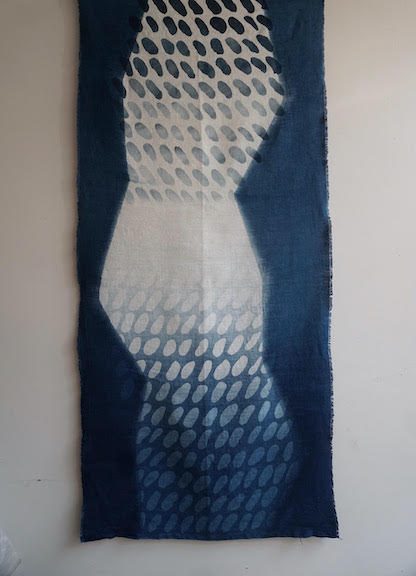Chinatsu Nagamune is an ESOL student in ILI’s Free English classes for Immigrants and Refugees. The background of her Zoom screen reveals fabrics of a beautiful deep blue color.
 Chinatsu uses traditional Japanese techniques, such as rice resist paste and hand-cut paper stencils, to create her patterns. The results are stunning: waves and eyes, concentric circles, and sharp lines. It’s all thanks to the indigo, she explains, which she ferments herself in her studio. As a textile artist she compares the practice of her art to the art of language learning, which she has enthusiastically taken up in ILI’s learning community.
Chinatsu uses traditional Japanese techniques, such as rice resist paste and hand-cut paper stencils, to create her patterns. The results are stunning: waves and eyes, concentric circles, and sharp lines. It’s all thanks to the indigo, she explains, which she ferments herself in her studio. As a textile artist she compares the practice of her art to the art of language learning, which she has enthusiastically taken up in ILI’s learning community.
When Chinatsu creates her intricate textile art, with a wide range in patterns and items, she uses all naturally sourced dyes. Growing up in a city, she says it was harder to have a connection to the natural world, so she finds the process of naturally dyeing fabrics grounding. Even when she was a kid, says Chinatsu.
I really loved drawing and picking up a lot of objects, and I like collecting a lot of objects like cicada shells, or, like, bark and I’d take them and put them in jars. I grew up in a city and there’s not a lot of nature, so probably as a reaction to that I was very obsessed with nature. So what I’m doing now is very focused on natural materials, from nature. So my dyeing plan is all from plants, dyeing pigments and all the stuff are all from nature…so that makes me very happy and feel very comfortable to work with.
Most of Chinatsu’s art uses indigo dye, which can be fickle; it needs to be fed every day. Chinatsu describes the process of tending to the indigo dye as a dialogue: “It’s always a conversation with the materials.” Over time, she says, you get to know the dye and you can react to it. You learn to know when to add more and when to let it sit. It’s a process of give and take; just like a speaking conversation, it involves listening and learning.
describes the process of tending to the indigo dye as a dialogue: “It’s always a conversation with the materials.” Over time, she says, you get to know the dye and you can react to it. You learn to know when to add more and when to let it sit. It’s a process of give and take; just like a speaking conversation, it involves listening and learning.
Chinatsu’s art shows how learning a new language is a lot like the fermentation process. It takes time, but the more time that is devoted to it, the stronger it grows. A little bit of knowledge over time, like learning a new word every day, adds up. It’s also a deeply personal process: although there are guides to fermentation, and many for language learning, too, language varies immensely from person to person, and even from one day to the next. To learn a language is to be in a state of constant evolution and growth.
Chinatsu says that the community environment of ILI is what keeps bringing her back to learn in her artistic way: “We have all different  backgrounds, we can talk about things without any judgment, and I think it is a very, very safe place for me and a really great way to jump into the community.” Instead of being worried about making mistakes, she is able to fully engage with her peers and with the English language. For Chinatsu, ILI is a welcoming environment where she feels comfortable with her skills and be confident practicing public speaking. She had lots of public speaking experience in Japanese, she says, but not as much in English until she practiced with the ILI community. ILI also connected her with an instructor who helped her practice presentations about dyeing fabrics. This summer, Chinatsu plans to host workshops to share her knowledge of textile art. She looks forward to teaching her skills to the entire Connecticut River Valley community.
backgrounds, we can talk about things without any judgment, and I think it is a very, very safe place for me and a really great way to jump into the community.” Instead of being worried about making mistakes, she is able to fully engage with her peers and with the English language. For Chinatsu, ILI is a welcoming environment where she feels comfortable with her skills and be confident practicing public speaking. She had lots of public speaking experience in Japanese, she says, but not as much in English until she practiced with the ILI community. ILI also connected her with an instructor who helped her practice presentations about dyeing fabrics. This summer, Chinatsu plans to host workshops to share her knowledge of textile art. She looks forward to teaching her skills to the entire Connecticut River Valley community.
Check out Chinatsu’s website for more information.
Interview and article by Emma Germanetto, UMass Amherst Community Engagement Course: Multilingualism and Literacy, spring 2022